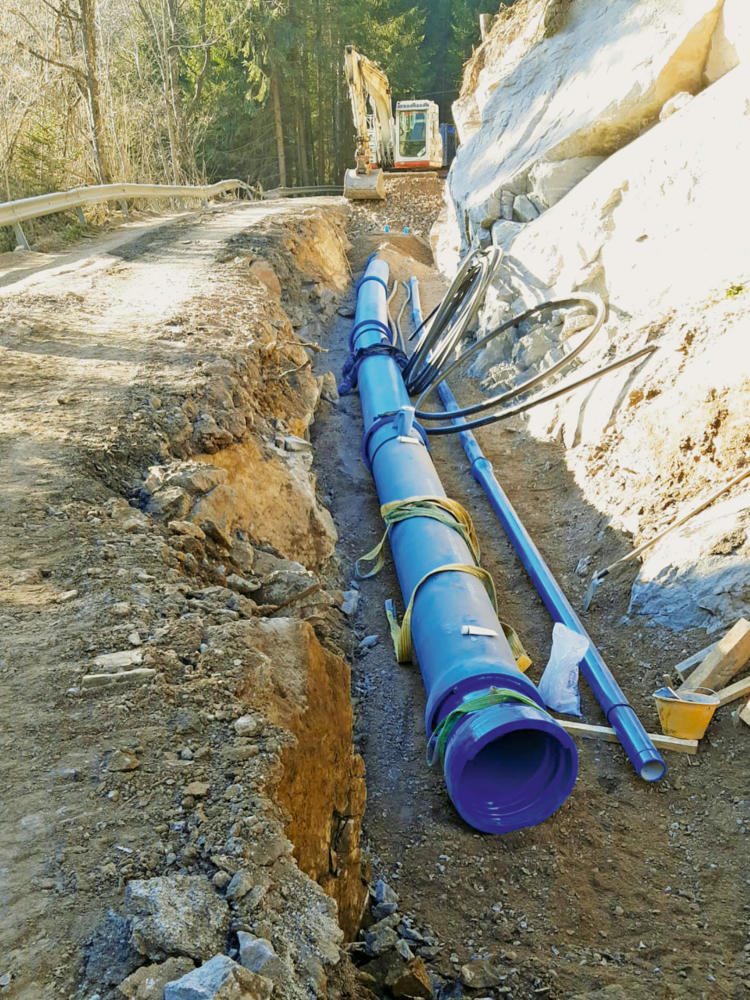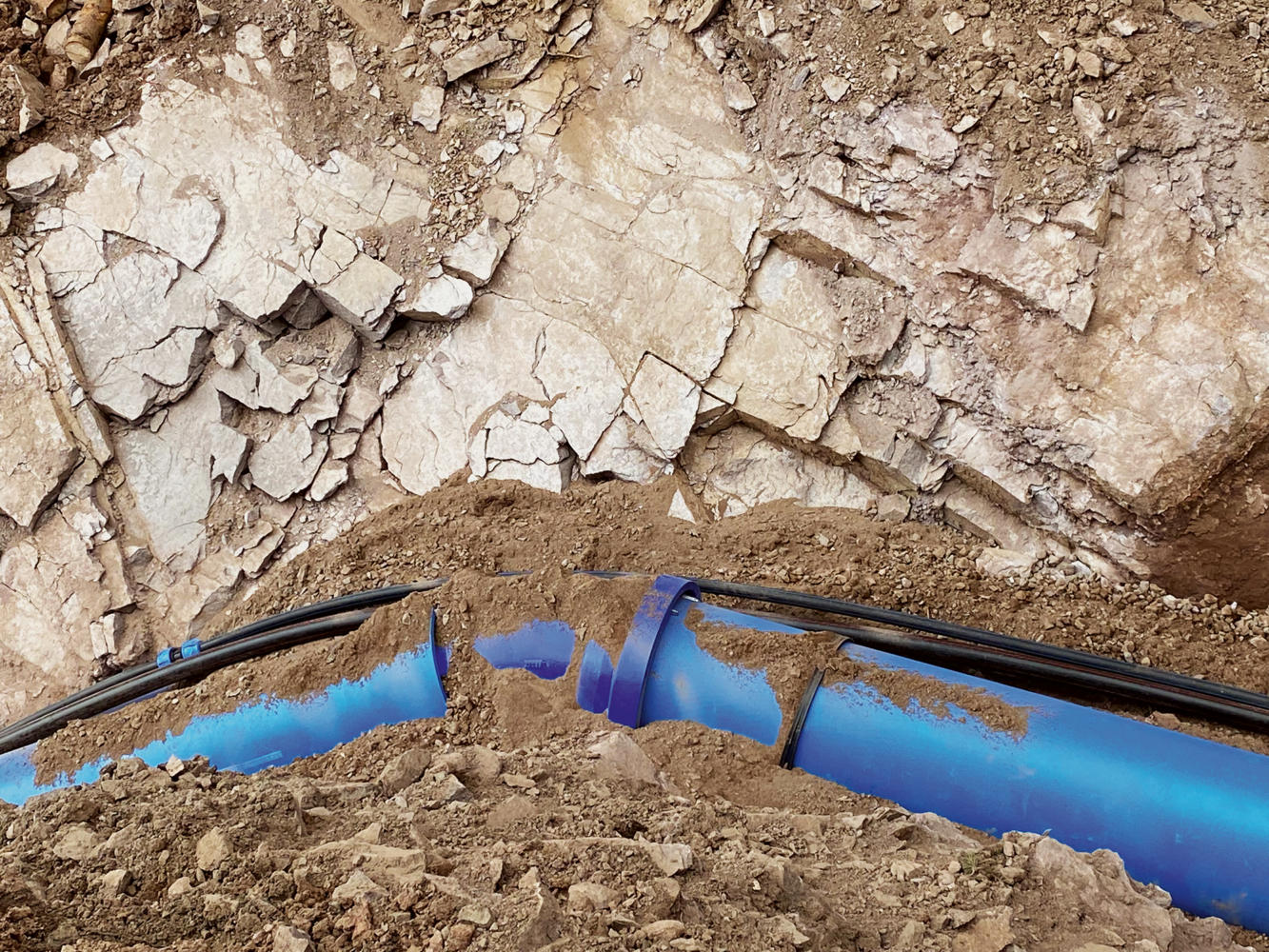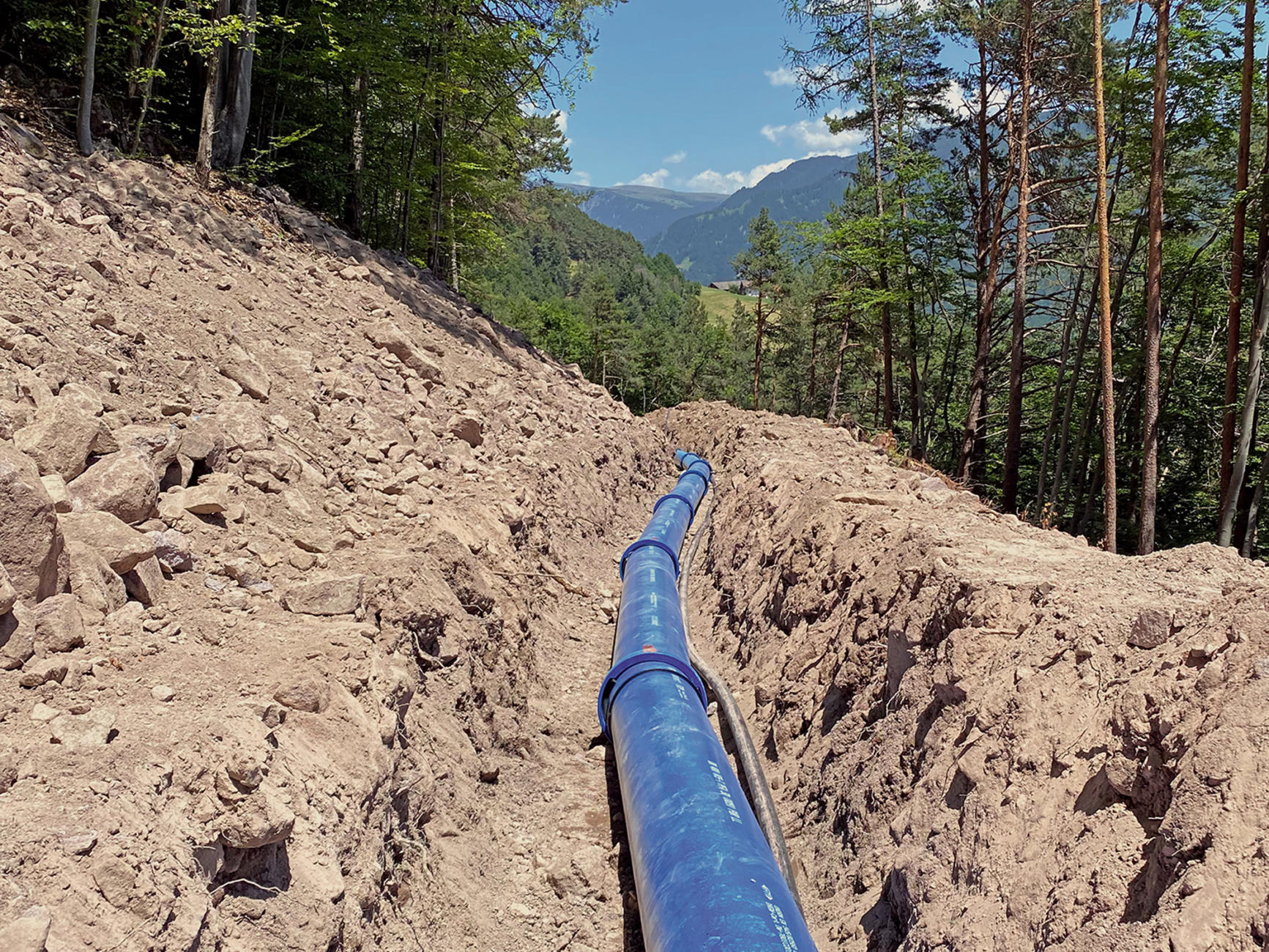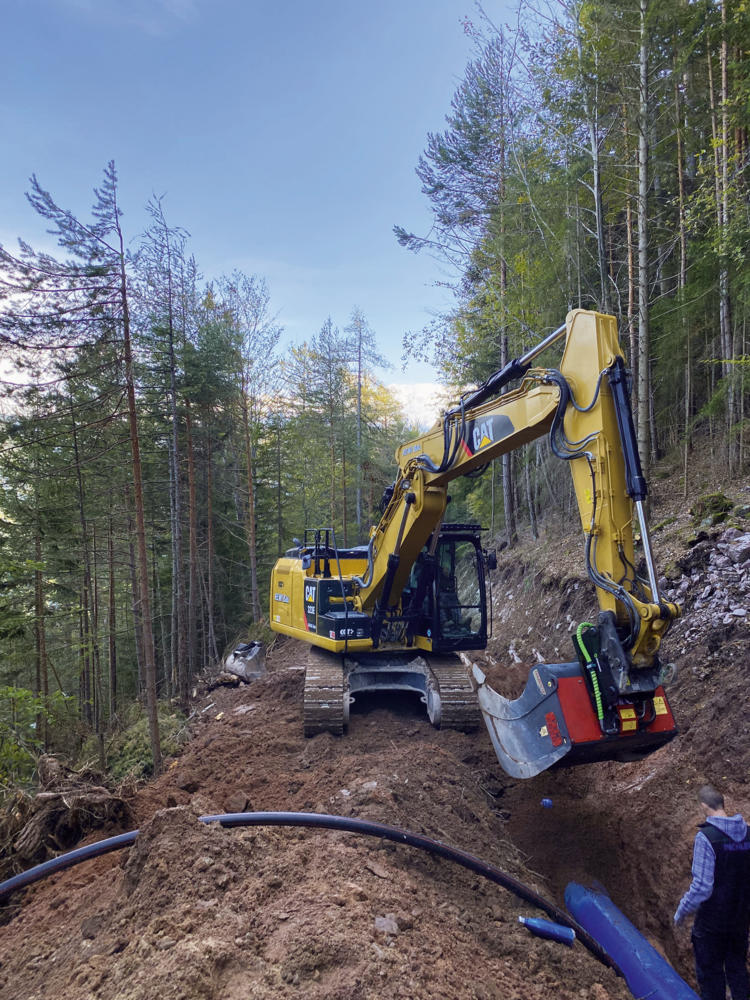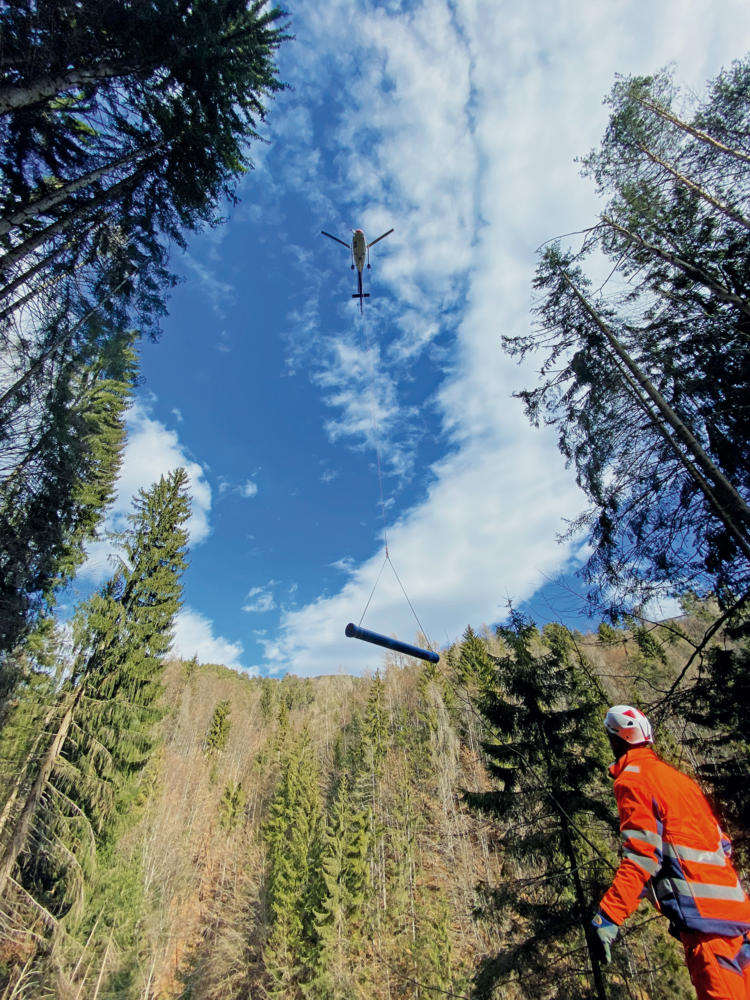Generation Project for South Tyrol‘s Dry Zone
Cast iron pipe systems ensure vital water supply
Many plans have been devised and abandoned to supply water to the farmers on the Tschögglberg in the Bolzano area, who are suffering from water shortages. But now a solution has been found. From March 2021, construction companies will be working at full speed on a record-breaking supply pipeline that will bring water from the Sarntal valley to Jenesien, some 20 kilometres away, under its own pressure. The pipeline, which will have to overcome a drop of 16 metres, has been built using mainly shear- and tensile-strength cast iron pipes from TRM Tiroler Rohre GmbH. It will ensure a reliable water supply for the farming community on the Tschögglberg for decades to come, helping them to survive in increasingly dry times.
Parallel to the new water supply pipeline, a drinking water pipeline was also laid in the two municipalities of Jenesien and Sarntal. For the first time, more remote farms are now also connected to the drinking water network.
Solution sought
Along with the Vinschgau Valley, the Tschögglberg, a mountain ridge in the immediate vicinity of Bolzano, is one of the dryest areas in South Tyrol. It is not only the low rainfall but also the scarce natural water reserves that are causing problems for local farmers. Under the influence of climate change, these conditions have increasingly become an existential threat to agriculture. “The farmers on the Tschögglberg have been suffering from water scarcity for decades. Without additional water, they would be deprived of their livelihood and would be part of the group of farmers who can now only farm as a sideline,” says Jenesien’s Mayor Paul Romen. One of the farmers formerly affected is Markus Plattner, whose family has been farming on the Tschögglberg for generations. For him and his colleagues, a technical solution to the problem was unavoidable. “Until recently, we used even the smallest resources, all the springs and rivulets. This was the only way to keep agriculture going. Our drinking water was pumped up many metres in altitude,” says
Plattner.
Generation project found
It was not due to a lack of will to remedy the situation. Numerous ideas have been tossed around in recent decades, as Mayor Paul Romen confirms: “There have actually been many initiatives to bring water to the Tschögglberg. One of several planned projects included a water transfer from the Passeier Valley. But all initiatives initially came to nothing. One time it was disputes, then financial aspects and another time the concessions. It wasn’t until 2010 that a new, promising initiative was launched with the founding of the Jenesien soil improvement consortium.”
Irrigation or electricity production?
The main idea behind this initiative was to transfer water from the Sarntal valley, which was blessed with plenty of water, over to Jenesien. A bold plan that included a pipeline across three municipal areas and water supply from an existing power plant diversion. “At that time, many hydroelectric power plants were being planned and built in South Tyrol. It was correspondingly difficult to obtain the concession for water utilisation in view of the usual subsidy tariffs at the time,” recalls Paul Romen. But that was exactly what the president of the consortium, Markus Plattner, had in mind; it was his primary goal.
To this end, the initiators relied on the South Tyrolean water management plan, which essentially guarantees certain water shares for agriculture. As the project gradually became more concrete, initial feasibility studies and a corresponding preliminary project followed. Fortunately for the farmers on the Tschögglberg high plateau, the question of whether the water would be used for electricity production or irrigation had now been decided. In 2016, the soil improvement consortium received the long-awaited licence to use the Sarntal Valley water at a rate of 96 l/s for 30 years.
Rome financed
However, this stage victory did not yet mean the green light for realisation, as Mayor Romen explains: “There were still a number of issues to be resolved. On the one hand, there were political disputes, as project opponents had formed who saw a possible burst pipe as a high risk potential for neighbouring residents. However, this was contrary to all reports and expert opinions. The matter had to be clarified in court. And then there was the important question of financing.”
The latter in particular was ultimately to be a tightrope act. The project operators wanted to generate the estimated 12.6 million euros from subsidies from the European Structural Fund for Agriculture. The political tailwind seemed favourable. The province of South Tyrol supported the project and Rome agreed to finance 100% of it. “For us as a private consortium, it would not have been economically feasible,” admits Markus Plattner. It remained exciting right to the end: it was only in his last session as Prime Minister in 2018 that Matteo Renzi managed to get the financing finalised in parliament. This cleared the way for the project. According to Mayor Romen, this is the first project of its kind in Italy for which funding of this magnitude has been obtained.
Win-win situation for several parties
However, the joy was not unclouded everywhere. In the municipality of Sarntal in particular, voices were raised claiming that the valuable water was being given away carelessly. For Deputy Mayor Josef Mair, who has been involved in the project from the very beginning, this was not an easy situation. “Many people didn’t realise that these 96 l/s were part of an existing power plant discharge anyway. This water had been channelled to Bolzano since the 1950s by the former ENEL for electricity production,” says Mair. In the meantime, the wind has changed and most of the former critics are now aware that the project has many beneficiaries – and the municipality of Sarntal is one of them. After all, even in the water-rich Sarntal Valley, the aim was to expand the existing irrigation system, which had to be emptied during the dry winter months. In addition, until recently some farms in the Sarntal Valley did not have a connection to the municipal drinking water network.
“The construction costs for projects of this kind quickly run into the millions and are difficult for a small municipality to manage. By being able to join the pipeline project with our plans, we have created a winwin situation,” says the Deputy Mayor happily. In addition to improving the water situation on the Tschögglberg, the synergies of the project also include the laying of a drinking water pipeline – both in Sarntal and in Jenesien – as well as the laying of an electricity line and fibre optic cable. An important measure for the structuring of the rural area in the Bolzano region.
Up to 15 construction sites were active at the same time during the intensive construction period.
Construction company struggles with Sarner porphyry
Once the financing had been secured, all the official hurdles had been cleared and the construction lots had been awarded, the first excavators were able to start work in March 2021. The construction of the water pipeline was awarded to the bidding consortium STRABAG and UNTERHOFER GmbH, who practised a clear division of tasks: While STRABAG, as the larger partner, was responsible for the entire organisation, administration and material procurement, consortium partner UNTERHOFER took on the earthmoving work. “One of the main challenges for us was that the planned pipe route was difficult or impossible to access in some places. Existing access roads therefore had to be built or extended. Around 10 hectares of forest had to be cleared and numerous retaining walls had to be built,” explains STRABAG project manager Dr Marco Guandalini. However, he considered the geological conditions to be the greatest challenge in terms of construction: “Sarner porphyry, which is generally known for its hardness and great resistance, prevails here throughout. This means that we blasted around 10,000 m³ out of the rock for the access roads and a further 5,000 m³ to 6,000 m³ for the trench. In the end, we encountered more rock than originally assumed.”
Another key challenge for the project manager was coordinating the numerous construction sites along the route. During the most intensive construction phase, 15 groups were working simultaneously on various construction sites with a total of 45 excavators. Every effort was made to ensure the high rate of work. To deliver the pipe sections to the most inaccessible parts of the route, for example, those responsible also relied on the helicopter. So far, the helicopter has delivered the pipes to the trench over a distance of around 1.2 to 1.5 kilometres.
20 km of cast iron pipes
The entire structural realisation followed the plans of the Weiss and in.ge.na planning offices, both based in Bolzano, which were also responsible for the construction management together with the Geologia e Ambiente office. For Dr Rudi Bertagnolli, the project manager at in.ge.na, this was a particularly exciting project. For the planners, everything revolved around the central question: how can a distance of almost 20 kilometres be bridged from the catchment point in the Sarntal valley to the reservoir on the Tschögglberg, 16 metres below, with as little loss as possible using only internal pressure? “The challenge for us was to correctly calculate the water pressure for the length. There is a total difference in altitude of 350 metres along the route, so the pipeline essentially runs up and down following the topography,” says Rudi Bertagnolli, explaining why the quality of cast iron pipes from the traditional Tyrolean manufacturer TRM: “With pressure classes from PN 35 to PN 45, it was clear to us that we would use cast iron pipes. In order to minimise frictional resistance, a large pipe diameter of DN 500 was chosen for the maximum flow rate of 96 l/s. This way, the water still reaches the Tschögglberg with sufficient pressure, where it is fed to the individual farms via numerous smaller distribution pipes.”
In general, those responsible focused on the highest quality of the pipe material used and clearly favoured the properties of the cast iron pipes from TRM. In addition to the technical application knowledge of the TRM experts, the focus was primarily on the partnership- based and solution-orientated approach to the highly demanding project. According to project manager Marco Guandalini, it was not only the ease of installation that spoke in favour of the TRM pipe system, but also the long service life and, of course, the enormous resistance of the pipeline, especially in alpine terrain. The longitudinally force-fit VRS®-T connection is able to absorb subsidence and slope movements and prevent the ingrowth of vegetation. It is even considered earthquake- proof. There was no need for complex and expensive fixed points. “Due to the topography, the pipeline already has some high and low points, and we also had to integrate some pipe bends,” adds Marco Guandalini.
Spectacular gorge crossing
As of April 2022, almost 85% of the main pipeline, i.e. over 45 km (cast iron pipes and PE supply lines), had already been laid. STRABAG and UNTERHOFER expected that the pipeline would essentially be completed by the end of summer 2022. Only one detail was still missing – the connection across the striking Martertal valley. This is a rugged rocky gorge that forms the border between the municipalities of Val Sarentino and San Genesio. “The only connection from Bolzano to Val Sarentino used to run along a steep mule track here,” explains Mayor Romen. As Rudi Bertagnolli emphasises, it was unthinkable to lay the pipeline in the terrain. “That’s why the idea of a pipe bridge was developed to span the gorge. In the course of the project, however, this became something more.
In order to achieve further synergy effects here too, the plan for a pedestrian bridge over the gorge was eventually spun out of the pipe bridge. “This is definitely a technical challenge. But in corona times, we also faced completely different challenges: For example, there were supply bottlenecks for the steel cables required for this. It was also not easy to get the right skilled personnel. We therefore didn’t expect completion until autumn 2022,” says the planner.
The 1.20 metre wide pedestrian bridge has the potential to become a real flagship for the region. After all, it will span the Martertal valley over a length of 270 metres, and at its lowest point it will tower 110 metres above the valley floor. Until the entire bridge is completed, a temporary structure will take over the “work”.
Dust clouds over the valleys
In general, those responsible have been confronted with developments in recent months that were not to be expected in this form: Rudi Bertagnolli: “The sometimes galloping price increases have been a real headache. You have to imagine that the price of reinforcing steel alone has risen by over 80% in recent months. But fuel prices were also a noticeable burden for construction companies. It is therefore no wonder that the price of the planned bridge has also risen recently.” However, the patience and understanding of the population of the affected villages was also severely tested, as both community leaders emphasise. “So much heavy equipment naturally caused stress for the population – the noise, blasting, traffic jams and especially the dust. We had a dry phase in which clouds of dust covered the valleys,” says Deputy Mayor Josef Mair from Sarntal, who is delighted that this unpleasant part of the project is now a thing of the past.
Automated distribution system
Since April 2023, Sarntal Valley water has been flowing onto the fields for the first time (via the still provisional bridge). A real turning point for the farmers on the water-poor but very sunny mountain ridge in the south-west of the Sarntal Alps. In concrete terms, this means that around 60 members of the soil improvement consortium now have 0.5 litres per hectare at their disposal. The affected area covers around 200 hectares. An important aspect here was the integration of a technically modern and sophisticated system for distribution, as Markus Plattner emphasises: “All of the sampling stations are equipped with professional pressure gauges. Special software was created that every member can operate via mobile phone, PC or tablet. Acceptance, distribution and monitoring are always automated. This is essential as the topography of the line could result in excessive pressure if a user forgets to close it”.
Responsible use of water
For Markus Plattner, it is clear that the use of water must also be carefully monitored. “Not least because we benefit from EU funding here, it is important to us that we continue to uphold the guiding principle of sensitive and responsible handling of the precious resource of water. That is why it is also important that irrigation is carried out precisely and meticulously and is also documented,” says the farmer. He also points out that the new irrigation system will also bring ecological improvements. Firstly, there will be no more water tanker deliveries, and secondly, the smaller streams and springs will be used less intensively, which will benefit flora and fauna. “Another important advantage is that the clear water from the Sarntal can also be used as drinking water in emergencies,” explains Jenesien’s Mayor Romen.
The water supply pipeline from Sarntal to Jenesien is definitely a generational project that will create enormous added value for one of the driest regions in South Tyrol. Only recently, the well-known South Tyrolean climate researcher Prof Ulrike Tappeiner explained that the ongoing climate change will tend to exacerbate the dry phases in the central location of the Tschögglberg, whereas the amount of precipitation in the Sarntal will increase according to calculations. This is yet another argument for the importance of the new supply line.
Authors:
Christoph Obkircher and Luca Frasson

